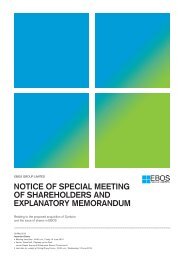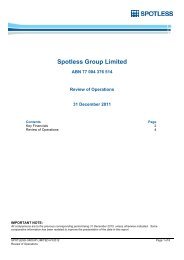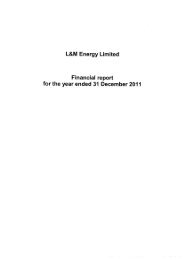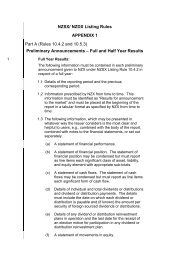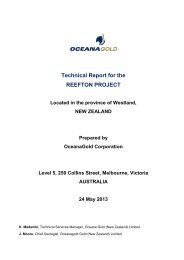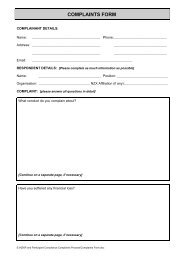Westpac Group Pillar 3 Report March 2013 - Iguana IR Sites
Westpac Group Pillar 3 Report March 2013 - Iguana IR Sites
Westpac Group Pillar 3 Report March 2013 - Iguana IR Sites
You also want an ePaper? Increase the reach of your titles
YUMPU automatically turns print PDFs into web optimized ePapers that Google loves.
PILLAR 3 REPORT<br />
LIQUIDITY RISK<br />
Liquidity risk is the risk that the bank will be unable to fund increases in assets and meet obligations as they come<br />
due, without incurring unacceptable losses.<br />
Approach<br />
<strong>Group</strong>-wide liquidity management is the responsibility of the Treasurer under the oversight of the BRMC and<br />
ALCO. Liquidity modelling is performed for the <strong>Westpac</strong> <strong>Group</strong>.<br />
Key aspects of the liquidity management strategy are:<br />
Liquidity risk management framework<br />
The BRMC approves <strong>Westpac</strong>’s policies for liquidity risk management annually or bi-annually as appropriate,<br />
including:<br />
modelling approach;<br />
scenarios covered;<br />
limit determination; and<br />
levels of liquid asset holdings.<br />
Funding strategy<br />
<strong>Group</strong> Treasury undertakes an annual review of the funding profile consistent with expected market conditions and<br />
the balance sheet growth of customer deposits and loans. The funding strategy is approved by BRMC annually.<br />
To further strengthen the management of the <strong>Group</strong>’s funding, the Stable Funding Ratio (SFR) is used to focus on<br />
the composition and stability of the overall funding base. Stable funding consists of customer deposits, equity and<br />
wholesale term funding with residual maturity greater than twelve months (including securitisation). As at 31 <strong>March</strong><br />
<strong>2013</strong>, the stable funding ratio was unchanged from 30 September 2012 at 83%. Refer to section 2.4.2 Funding<br />
and Liquidity Risk Management in <strong>Westpac</strong> <strong>Group</strong> Interim Results <strong>2013</strong> for further detail.<br />
Contingency planning<br />
<strong>Group</strong> Treasury maintains a Crisis Management Action Plan that details the broad actions that should be taken by<br />
<strong>Westpac</strong> in the event of an emerging ‘funding crisis’. The plan is reviewed and approved by the BRMC and is<br />
aligned with the <strong>Group</strong>’s broader situation management procedures.<br />
Minimum liquid asset holdings<br />
<strong>Westpac</strong> holds a portfolio of liquid assets that are eligible to be used as collateral for repurchase agreements with<br />
the Reserve Bank of Australia. The BRMC annually approves minimum holdings of liquid assets.<br />
<strong>Westpac</strong> complies with local regulatory liquidity requirements in its offshore operations. <strong>Westpac</strong> has been granted<br />
a global liquidity concession by the Financial Services Authority in the United Kingdom, under which many aspects<br />
of liquidity regulation of its UK operations are performed by APRA.<br />
Liquidity reporting<br />
Daily monitoring of the liquidity risk position is conducted by the Liquidity Risk unit in <strong>Group</strong> Risk, which monitors<br />
compliance with crisis funding, normal funding and liquid asset holding limits. The daily liquidity risk reports are<br />
circulated to, and reviewed by, local and senior staff in both Treasury and the independent Liquidity Risk unit.<br />
Summary liquidity reports are submitted to ALCO and APRA monthly, and to BRMC quarterly.<br />
Recovery and Resolution Planning<br />
In November 2011, the Financial Stability Board, a global financial authority, finalised a comprehensive package of<br />
policy measures to improve the capacity of authorities to resolve failing Systemically Important Financial<br />
Institutions (SIFIs), without systemic disruption and without exposing taxpayers to risk of loss. As part of the<br />
package, a Recovery and Resolution Plan is required for any firm deemed by its home authority to have systemic<br />
importance to the domestic economy. In addition, domestic and global SIFIs will be subject to resolvability<br />
assessments to ensure they may be resolved without severe systemic disruption and taxpayer loss while at the<br />
same time protecting systemically important functions. APRA has undertaken a pilot Recovery Planning project<br />
applying to Australia’s largest banks, with final plans delivered to APRA in mid-2012. APRA has indicated that it<br />
intends to extend its recovery planning program once the results of the pilot program have been analysed. The<br />
final form of any resulting requirements, the implications and the timing for <strong>Westpac</strong> are at this stage unknown.<br />
76



